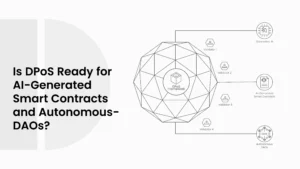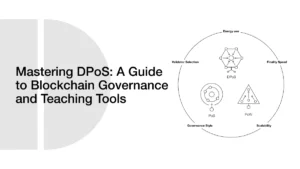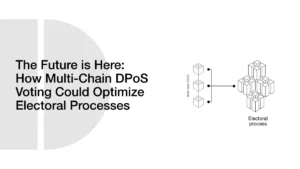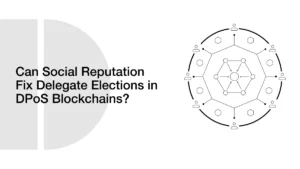How Regulatory Compliance in DPoS Dawns a New Era in Blockchain Governance
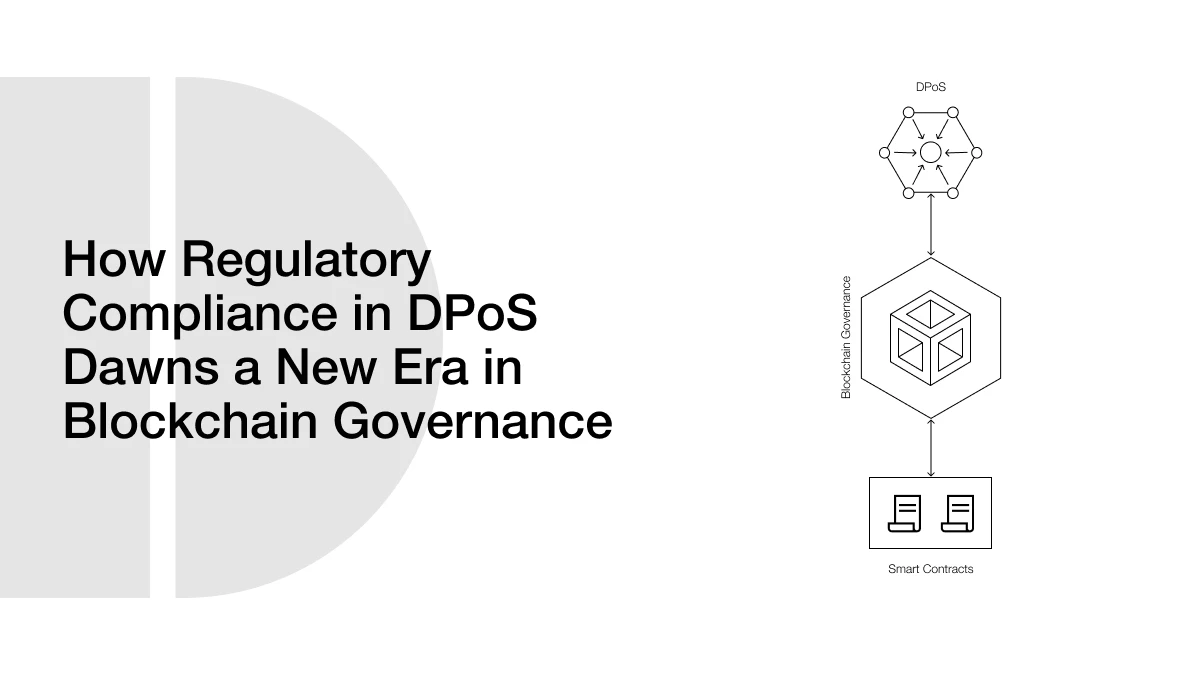
The initial rave about blockchain technology was that it would be decentralized, transparent, and not subject to the old authority system. But as this technology grows, it has new responsibilities, especially in how decisions are made in its networks. Delegated Proof of Stake (DPoS) is one of the most popular models of governance in blockchain. As part of DPoS systems, users are allowed to select a small number of trusted individuals or organizations known as block producers to verify transactions and propose changes to the network.
- How DPoS Works: Voting, Staking, and Delegates
- What is Delegated Proof of Stake (DPoS)?
- Stake-Weighted Voting and Its Role
- Real-World Examples
- Centralization Risks in DPoS Voting (Backed by Research)
- How Centralization Happens
- What Research Reveals: The VPA Factor
- The Steem Takeover: What Went Wrong?
- Tron Acquires Steemit and Control
- The Fork War Begins
- The Lesson: Poor Voting Rules Invite Centralization
- What Is VPA, and Why Does It Matter?
- Defining VPA
- Why VPA Matters for Security
- Balance Is Key
- Role of Regulatory Compliance in DPoS Elections
- Why Compliance Matters in Voting
- Applying Compliance to DPoS Elections
- KYC for Block Producers
- Auditing Voting Behavior
- Preventing Vote Selling or Delegation Abuse
- Creating Smart Contracts for Governance Commitments
- Regulatory Blind Spots: Where the Law Still Fails
- 1. Cross-Border Confusion
- 2. Anonymity and Sybil Attacks
- 3. Smart Contracts and Legal Gaps
- Lack of Public Protection
- What Blockchain Projects Can Do Today
- 1. Set the Right VPA (Votes Per Account)
- 2. Use Smart Contracts to Lock Votes
- 3. Make Voting a Required Action
- 4. Publicly Commit to Governance Fairness
- 5. Educate Users About Their Power
- TRC Values in Real DPoS Chains
- Balancing Freedom and Fairness in DPoS
- Frequently Asked Questions (FAQs)
- Glossary of Key Terms
This voting system is designed to make blockchain fair and decentralized. But it doesn’t always turn out that way. A prime example of how vulnerable DPoS can be when the rules are ambiguous or poorly crafted is the 2020 Steem takeover incident, in which the Tron Foundation leveraged its voting power to seize control of the Steem blockchain (Jeong, 2021). That is where regulatory compliance comes in.
This blog will explore how regulatory compliance is shaping the future of DPoS voting systems. Let’s learn about how the system works, what went wrong in the Steem case, how voting rules like Votes Per Account (VPA) impact fairness, and what the latest research says about how to keep blockchain governance both secure and flexible. The conversation about compliance isn’t just about following laws. It’s about protecting the future of blockchain itself, especially systems that rely on user voting. And in the case of DPoS, the stakes couldn’t be higher.
How DPoS Works: Voting, Staking, and Delegates
To understand why regulatory compliance matters in DPoS systems, you first need to know how the system itself works.
What is Delegated Proof of Stake (DPoS)?
Delegated Proof of Stake (DPoS) is a way that numerous blockchains have employed to achieve agreement (or rather, consensus) on which transactions are valid. Rather than having each user confirm each transaction individually, users elect a smaller set of representatives, the so-called block producers or witnesses, to secure the network. The greater the number of tokens that the user possesses, the greater their voting power.
It is more efficient and energy-saving than Proof of Work (PoW) protocols, such as Bitcoin, which must be confirmed with intensive computing power (Nakamoto, 2008). In DPoS, block producers are selected, and in turn, they verify transactions and add them to the blockchain. Such representatives can also propose changes to the network, such as a rule change, software upgrade, or even a new version of the chain known as a fork.
Stake-Weighted Voting and Its Role
The voting process in DPoS is not equal across all users. It is stake-weighted, i.e., the more tokens a user has, the more influential they are. For example, a person who has 1,000 tokens will possess 10 times more voting rights than a person with 100 tokens. A user can vote directly or give their voting power to another person they trust.
ALSO READ: Can DPoS Blockchains Handle Over a Billion Transactions Per Day?
However, such a structure leaves the possibility of centralization. By having a significant number of the tokens, a few users or actors will have control over the election and alteration of the rules of the blockchain. This control can be overwhelming and very hazardous in systems where a supermajority of block producers (such as 17 out of 20) can make crucial decisions.
Real-World Examples
DPoS is used in many popular blockchain projects such as EOS, Tron, and Steem. Their structure differentiates the two in terms of voting and governance. An example is that Steem gives its users an option to vote up to 30 block producers, whereas Tron only offers one. These figures are termed as Votes Per Account (VPA), and they are significant in determining the security and fairness of the system.
In theory, DPoS gives every user a voice through delegation. In practice, however, poorly designed voting rules and a lack of regulatory oversight can lead to takeovers, as we saw with the Tron and Steem conflict in 2020 (Jeong, 2021).
Centralization Risks in DPoS Voting (Backed by Research)
Although the Delegated Proof of Stake (DPoS) protocol is aimed at facilitating decentralization and high performance, studies indicate that it may succumb to centralization. The fact that some influential stakeholders may control votes means that they can make the system one-sided, with a decentralized platform turning into a platform with limited players.
How Centralization Happens
In DPoS systems, the number of block producers (BPs) is limited, and users choose them through stake-weighted voting. But if one user or organization controls a large number of tokens, they can elect their own block producers. This allows them to not only confirm transactions but also make critical decisions about the future of the blockchain.
The Tron-Steem takeover in 2020 is a perfect example. When the Tron Foundation acquired Steemit Inc., it used its token holdings to vote in 20 new block producers, replacing the existing ones. As a result, they gained complete control of the Steem blockchain and implemented a fork that reversed a community-led block on their tokens (Jeong, 2021). This showed how a lack of regulatory oversight and poorly designed voting rules can lead to real power grabs.
What Research Reveals: The VPA Factor
One significant insight from Jeong’s 2021 study is that Votes Per Account (VPA) plays a key role in preventing takeovers. If users can vote for too many block producers at once (as was the case with Steem’s VPA of 30), it becomes easier for one entity to spread its influence widely and fill up the top ranks with its own candidates.
ALSO READ: 6 Mistakes New DPoS Stakers Make (And How to Avoid Them in 2025)
Jeong introduces a formula called the Takeover Resistance Coefficient (TRC), which shows how much stake an attacker would need to take control. The research found that lowering the VPA increases the amount of stake needed for a takeover, up to a certain point. This means that setting the right VPA is one of the most critical decisions in DPoS governance.
For example, in the case of Steem:
- With a VPA of 30, the TRC was just 1.0, making the takeover easy.
- If the VPA had been reduced to 4, the TRC would have increased to 4.25, making the attack almost impossible without buying up most of the market’s available tokens (Jeong, 2021).
This shows that centralization in DPoS is not just a theoretical risk; it’s a measurable and preventable one.
The Steem Takeover: What Went Wrong?
Steem blockchain was among the most popular networks based on Delegated Proof of Stake (DPoS). It also backed a well-liked social media platform known as Steemit, in which users were rewarded for content production. However, at the beginning of 2020, the platform was hit with a significant crisis that demonstrated critical flaws in its governance system.
Tron Acquires Steemit and Control
In February 2020, the Tron Foundation acquired Steemit Inc., the company that had helped develop the Steem blockchain. At first, this looked like a business decision, but things quickly changed. The Tron Foundation held a large amount of Steem tokens, and it used those tokens to vote in 20 new block producers, replacing the existing community-elected ones. This allowed Tron to control the entire Steem network (Jeong, 2021).
What made this possible was Steem’s high VPA (Votes Per Account). Each user could vote for up to 30 block producers, exceeding the 20 needed to run the network. Tron used this rule to vote for all 20 of its own BPs using just a few large token-holding accounts. With help from a few major crypto exchanges, they pushed these new block producers to the top of the list.
The Fork War Begins
Before the takeover, existing community leaders tried to stop Tron’s influence by launching a software update (called fork version 0.22.2) that froze Tron’s voting tokens. But Tron quickly responded by reversing that update with a new version, 0.22.5, and regaining control. Eventually, Tron used its votes to change the rules again and locked out several community members.
This battle became known as a governance war, and it showed how unstable a DPoS blockchain can become when no outside rules or compliance systems are in place.
According to Jeong’s analysis:
- Tron only needed a TRC of 1.0 to win the takeover because of the high VPA.
- If Steem had chosen a lower VPA, such as 4, the required TRC would have been 4.25, meaning Tron would have needed to buy up nearly 72% of all liquid Steem tokens (Jeong, 2021).
- That level of investment would have made the takeover nearly impossible or very risky.
The Lesson: Poor Voting Rules Invite Centralization
The Steem case demonstrates that poorly designed governance, a high VPA in particular, can render a blockchain susceptible, despite the fact that it may seem decentralized at the surface. When there are no effective rules, commitments, or external checks (such as regulatory oversight), powerful actors can exploit the loopholes to make gains in their own favour.
This is the reason why the technical and regulatory aspects of voting systems are important to the future of blockchain governance.
What Is VPA, and Why Does It Matter?
In Delegated Proof of Stake (DPoS) systems, users vote for block producers who manage the blockchain. But how many different producers should one account be allowed to vote for? That number is called VPA, or Votes Per Account. And as it turns out, VPA plays a much bigger role in security than many blockchain developers realize.
Defining VPA
Votes Per Account (VPA) is the maximum number of candidates a single account can vote for during a block producer election. For example:
- On Steem, each account can vote for up to 30 block producers.
- On Tron, users are allowed only one vote per account.
- EOS allows 7, while Lisk allows 101 (Jeong, 2021).
VPA sounds like a minor rule, but it has a significant impact on who gets elected, how power is distributed, and how easy it is to take over the network.
Why VPA Matters for Security
A higher VPA means each account can vote for many candidates. While this may give users more flexibility, it also makes it easier for a single large account (or multiple accounts) to spread their influence and fill the top positions with their own block producers.
Jeong’s research in 2021 showed that when the VPA is high, the Takeover Resistance Coefficient (TRC) is low. This means an attacker needs fewer tokens to take control. For example:
- Steem’s VPA of 30 resulted in a TRC of 1.0, meaning a malicious actor needed only as many tokens as the defenders to succeed.
- If VPA had been lowered to 4, the TRC would have jumped to 4.25, forcing attackers to control over 4 times the stake of defenders to succeed (Jeong, 2021).
This shows that a lower VPA increases security, but only up to a certain point. After that, lowering it further doesn’t help much and can even reduce user flexibility.
Balance Is Key
Some blockchains, like Tron, try to solve the problem by using a strict “one vote per account” rule. This seems secure, but it can also limit users from supporting a diverse set of candidates. Worse, it may encourage users to create multiple fake accounts (known as a Sybil attack) to circumvent the limit.
Jeong’s research confirms that setting VPA too low can be as risky as setting it too high. Instead, there is an optimal VPA value that:
- Maximizes takeover resistance, and
- Still allows users enough flexibility to vote fairly.
This balance is different for every blockchain, depending on the number of block producers elected and the number required to approve changes. For example, Steem’s optimal VPA would have been 4, not 30.
Role of Regulatory Compliance in DPoS Elections
Delegated Proof of Stake (DPoS) systems rely heavily on community voting. But when there are no clear rules about who is voting, how they are voting, or whether votes are being manipulated, the system becomes weak. That’s where regulatory compliance plays a key role.
Why Compliance Matters in Voting
In traditional elections, whether for governments or companies, there are rules to ensure fairness. Voters must be verified, votes must be transparent, and influential players are limited in their actions. The same principles are now being applied to blockchain, especially as more money and influence flow into Web3 systems.
According to TokenMinds (2025), blockchain projects must now consider regulations just as seriously as they consider code. This includes:
- AML (Anti-Money Laundering): To stop illegal funds from entering the system.
- KYC (Know Your Customer): To verify the identity of voters and block producers.
- Cross-border compliance: To make sure international users are following local laws.
- Data privacy laws like GDPR: To handle user data correctly, especially in decentralized voting apps.
These rules are fundamental in DPoS systems, where voting power is based on token ownership and where a few large holders can dominate the process if left unchecked.
Applying Compliance to DPoS Elections
Here’s how regulatory compliance can directly improve DPoS governance:
KYC for Block Producers
Block producers in DPoS have huge responsibilities. They confirm transactions, receive rewards, and help control network upgrades. If these individuals or groups remain anonymous, it becomes easy for bad actors to enter the system. Requiring KYC verification for block producer candidates can prevent fraud and increase trust.
Auditing Voting Behavior
Compliance tools can track if exchanges, bots, or colluding parties are manipulating votes. This helps prevent cases like the Steem takeover, where the Tron Foundation used exchange-held customer tokens to swing the election (Jeong, 2021).
Preventing Vote Selling or Delegation Abuse
Regulations can help block illegal practices like selling votes or mass delegation to insiders. In a healthy DPoS system, voters should support candidates based on reputation, not based on bribes or hidden deals.
Creating Smart Contracts for Governance Commitments
TokenMinds (2025) also recommends that acquirers, such as the Tron Foundation in the Steem case, use smart contracts to lock or delay their voting power. This would act like a “cooling-off period,” giving the community time to react and reducing the chances of sudden takeovers.
Regulatory Blind Spots: Where the Law Still Fails
Even though regulators are starting to pay attention to blockchain, there are still huge gaps in how the law protects DPoS systems. These blind spots leave room for manipulation, confusion, and unfair practices. While statutes are improving, they are often too slow or unclear to handle the fast changes in blockchain technology.
1. Cross-Border Confusion
One of the biggest challenges is that blockchains are global. Anyone with internet access can join, no matter where they live. But laws about voting, taxes, financial control, or privacy are different in every country. So, if a blockchain like Steem has users in the US, China, and Europe, which country’s rules should apply?
ALSO READ: How to Delegate Tokens on a DPoS Blockchain (Step-by-Step Guide)
For example, if a takeover happens using an exchange in one country, can users in another country stop it? What if the attacker is in a place with no regulation at all? These questions are hard to answer and even harder to enforce. As (Token Minds 2025) explains, the borderless nature of blockchain creates major legal headaches.
2. Anonymity and Sybil Attacks
Blockchain allows users to stay anonymous or use fake names. While this protects privacy, it also creates risks. In DPoS, attackers can create many fake accounts, a strategy known as a Sybil attack, to gain extra voting power. Even though Jeong (2021) shows that Sybil attacks do not change the required stake in well-designed systems, most blockchains still struggle to detect or stop them.
In a real-world setting, no traditional voting system would allow this kind of anonymity without checks. But in blockchain, there is still no standard way to prevent a single person from controlling hundreds of accounts.
3. Smart Contracts and Legal Gaps
Smart contracts, self-running pieces of code, are used in DPoS to manage votes, rewards, and more. But what happens if one of these contracts has an error or is used in a scam? Who is responsible? There are no judges or court systems built into blockchain.
TokenMinds (2025) notes that smart contracts raise complex legal questions:
- Can a contract be canceled if there is fraud?
- What if the contract punishes the wrong person?
- How do you settle disputes without knowing who wrote the code?
These questions are not just technical; they are legal and ethical. And right now, most governments don’t have answers.
Lack of Public Protection
In a traditional system, regulators are supposed to protect the public from fraud, price crashes, or scams. But in blockchain, the rules are unclear. If a user votes for a bad block producer and loses money, is anyone responsible? Probably not.
This is dangerous in DPoS systems, where users may not fully understand the extent of their voting power. As seen in the Steem case, one strong voter can change the entire network, even if most users disagree.
What Blockchain Projects Can Do Today
Blockchain is still developing, and regulation continues to evolve. But DPoS-based projects don’t need to wait for new laws to protect their systems. They can take smart steps today to reduce takeover risks, improve transparency, and earn public trust.
1. Set the Right VPA (Votes Per Account)
One of the most effective things a blockchain project can do is adjust the VPA setting. As shown by Jeong (2021), there is an optimal VPA that:
- Increases the takeover resistance coefficient (TRC)
- Still gives users the freedom to vote for multiple candidates
For Steem, for example, the ideal VPA was 4. At this level, it would have been much harder for the Tron Foundation to gain control without buying most of the market’s liquid tokens. Setting the VPA too high (like 30) lowers TRC and invites centralization. Setting it too low (like 1) can limit voter choice and lead to Sybil attacks. The key is balance.
2. Use Smart Contracts to Lock Votes
A common issue in takeovers is when a powerful user suddenly uses their tokens to flip an election. To stop this, projects can use vote-locking smart contracts. These contracts can delay the effect of large votes, say, for 30 days, giving the community time to respond.
The Hive blockchain, which forked from Steem, introduced this delay system to protect itself from sudden attacks. This solution allows for defensive forks or vote coordination before the attacker takes over (Jeong, 2021).
3. Make Voting a Required Action
In many DPoS systems, voters are passive. Their votes stay active forever unless they manually change them. To make governance more active and informed, some blockchains could:
- Require users to vote periodically, especially during a fork or major upgrade
- Suspend token transfers until a user votes on key issues
- Introduce a vote expiration so old votes don’t affect the future unfairly
These rules would help ensure that only current, active voters are shaping the network, not long-lost token holders.
4. Publicly Commit to Governance Fairness
Acquiring teams, large token holders, or exchanges that participate in governance can also improve trust by making public commitments. For example, the Tron Foundation could have promised not to use its tokens for voting after acquiring Steemit. Instead of vague blog posts, these promises should be made through on-chain smart contracts.
This would show real commitment and give the community legal and technical assurance that centralization won’t happen overnight.
5. Educate Users About Their Power
Finally, users need to understand the power they wield through their votes. A project’s website, dashboard, or wallet interface should explain:
- What block producers do
- How votes are counted
- Why decentralization matters
Projects that help users vote wisely not only protect themselves, but they’re also building long-term value and community trust.
TRC Values in Real DPoS Chains
The following table shows how different Votes Per Account (VPA) settings affect the Takeover Resistance Coefficient (TRC) across major DPoS blockchains. A higher TRC means an attacker would need more stake to take over the network, which improves security.
| Blockchain | Block Producers (n) | Fork Threshold (k) | VPA | TRC (τ) | Max TRC (τ)* | Optimal VPA (v)* |
| Steem | 20 | 17 | 30 | 1.00 | 4.25 | 4 |
| Tron | 27 | 19 | 1 | 2.11 | 2.11 | 9 |
| EOS | 21 | 15 | 7 | 2.14 | 2.14 | 7 |
| Lisk | 101 | 68 | 101 | 1.00 | 2.00 | 34 |
Notes:
- TRC (τ) is calculated using:
τ = max(k, v) / max(n – k + 1, v)
(Jeong, 2021) - Max TRC (τ)* is the highest resistance possible with the best VPA value.
- v* is the number of votes per account that maximizes TRC without harming voter flexibility.
This table clearly shows that Steem’s TRC was dangerously low due to a very high VPA. If the project had used the optimal VPA of 4, it could have raised its TRC to 4.25, dramatically reducing takeover risk.
Balancing Freedom and Fairness in DPoS
The Delegated Proof of Stake (DPoS) system offers a fast, energy-efficient, and user-driven alternative to traditional blockchain consensus mechanisms. But as we’ve seen through both research and real-world cases like the Steem takeover, the system is only as strong as its voting rules and governance protections.
At the heart of DPoS governance lies a simple question: How do we make voting both secure and fair? Research by Jeong (2021) shows that one of the most powerful tools in answering that question is the Votes Per Account (VPA) setting. Too high, and the system becomes open to centralization. Too low, and it limits flexibility and may encourage vote-splitting through fake accounts. But when the VPA is optimized, such as with a setting of 4 for Steem, you get the best of both worlds: strong resistance against takeovers and meaningful voter choice.
At the same time, regulatory compliance is now essential. As TokenMinds (2025) outlines, compliance with AML, KYC, and data protection laws not only strengthens blockchain trust but also adds the kind of oversight that helps prevent abuse of power. Whether it’s verifying block producer identities, limiting sudden vote swings, or ensuring users understand their voting rights, regulation can support a healthier, more stable blockchain environment.
Ultimately, fair governance is not just about writing code or passing laws; it’s about building trust. And as blockchain grows in influence, DPoS networks that successfully balance freedom with protection will lead the world into a secure, decentralized future.
Frequently Asked Questions (FAQs)
Q1. What is VPA in DPoS systems?
VPA stands for Votes Per Account. It defines how many block producers one account can vote for in a DPoS blockchain. A high VPA gives more flexibility but can increase centralization risks.
Q2. Why is DPoS vulnerable to takeovers?
Because voting power is based on token ownership, users with a large number of tokens can vote in multiple block producers and control governance, especially when the VPA is too high.
Q3. How can regulation improve DPoS governance?
Regulatory compliance ensures fair elections by requiring KYC for block producers, preventing vote manipulation, and protecting users against fraud and centralization.
Q4. What was the Steem takeover?
In 2020, the Tron Foundation used its token holdings to vote in new block producers and take control of the Steem blockchain. This happened because the system allowed high VPA and had no governance safeguards.
Q5. What is TRC in blockchain voting?
TRC stands for Takeover Resistance Coefficient. It measures how much stake an attacker would need to take control of a DPoS blockchain. A higher TRC means better protection.
Glossary of Key Terms
Delegated Proof of Stake (DPoS):
A blockchain consensus system where token holders vote to elect a small group of block producers to verify transactions.
Votes Per Account (VPA):
The maximum number of different block producers one account can vote for.
Takeover Resistance Coefficient (TRC):
A metric that shows how difficult it is for an attacker to take over a blockchain. Calculated as the ratio of the attacker’s stake to the defender’s stake needed.
Smart Contract:
A piece of self-executing code on a blockchain that automatically carries out actions when conditions are met.
Sybil Attack:
A situation where one user creates many fake accounts to gain extra voting power or influence.
KYC (Know Your Customer):
A regulatory process used to verify the identity of users to prevent fraud and illegal activity.
AML (Anti-Money Laundering):
Laws and systems are designed to stop criminals from using blockchain or finance tools to clean stolen money.

